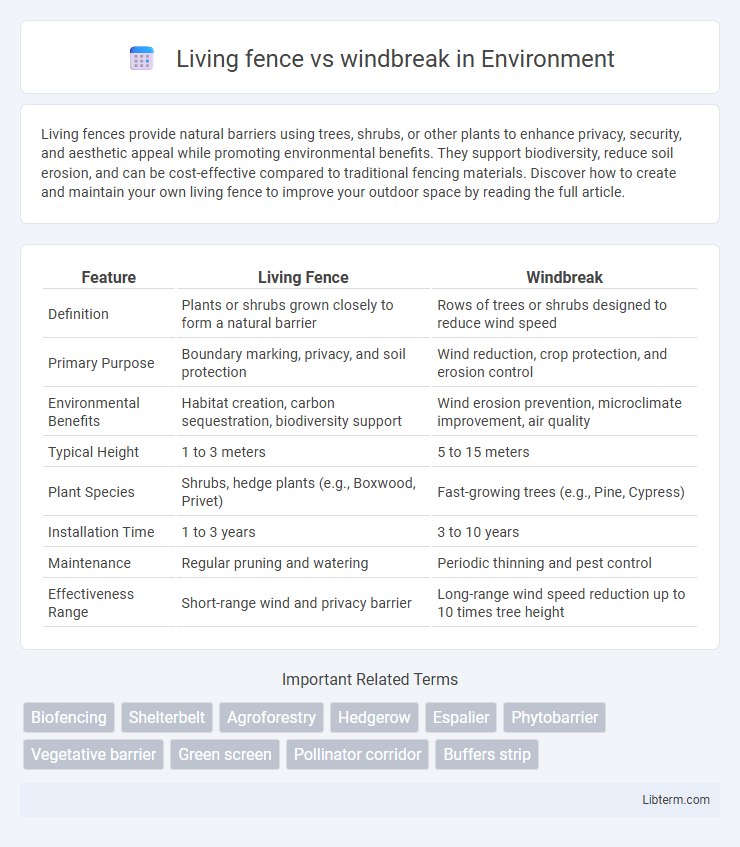Living fences provide natural barriers using trees, shrubs, or other plants to enhance privacy, security, and aesthetic appeal while promoting environmental benefits. They support biodiversity, reduce soil erosion, and can be cost-effective compared to traditional fencing materials. Discover how to create and maintain your own living fence to improve your outdoor space by reading the full article.
Table of Comparison
| Feature | Living Fence | Windbreak |
|---|---|---|
| Definition | Plants or shrubs grown closely to form a natural barrier | Rows of trees or shrubs designed to reduce wind speed |
| Primary Purpose | Boundary marking, privacy, and soil protection | Wind reduction, crop protection, and erosion control |
| Environmental Benefits | Habitat creation, carbon sequestration, biodiversity support | Wind erosion prevention, microclimate improvement, air quality |
| Typical Height | 1 to 3 meters | 5 to 15 meters |
| Plant Species | Shrubs, hedge plants (e.g., Boxwood, Privet) | Fast-growing trees (e.g., Pine, Cypress) |
| Installation Time | 1 to 3 years | 3 to 10 years |
| Maintenance | Regular pruning and watering | Periodic thinning and pest control |
| Effectiveness Range | Short-range wind and privacy barrier | Long-range wind speed reduction up to 10 times tree height |
Introduction to Living Fences and Windbreaks
Living fences consist of closely planted shrubs or trees that create a natural barrier, providing privacy and defining property boundaries while supporting biodiversity. Windbreaks are strategically arranged rows of trees or shrubs designed to reduce wind speed, protect soil from erosion, and improve microclimates for crops and livestock. Both living fences and windbreaks contribute to sustainable land management, enhancing ecological stability and agricultural productivity.
Key Differences Between Living Fences and Windbreaks
Living fences are dense plantings primarily designed to create physical boundaries and enhance privacy, often composed of shrubs or trees planted closely together. Windbreaks consist of rows of trees or shrubs arranged strategically to reduce wind speed and protect crops, soil, or buildings from wind damage. Key differences include their primary function--living fences emphasize enclosure and security, while windbreaks focus on minimizing wind impact--and their typical structural layout, with living fences being continuous barriers and windbreaks usually more spaced and linear.
Benefits of Living Fences
Living fences provide enhanced biodiversity by supporting habitats for pollinators and beneficial insects, which improves ecosystem health. They offer superior soil erosion control through dense root systems compared to traditional windbreaks. Living fences also increase carbon sequestration and can be harvested sustainably for fuel or fodder, adding economic value beyond wind protection.
Advantages of Windbreaks
Windbreaks provide significant advantages by reducing wind speed, which protects soil from erosion and helps conserve moisture essential for crop growth. They improve microclimate conditions, reducing plant stress and increasing agricultural productivity while offering habitat for beneficial wildlife species. Compared to living fences, windbreaks enhance energy efficiency by lowering heating costs through wind protection and contribute to biodiversity by supporting diverse ecosystems.
Plant Species Selection for Living Fences
Selecting plant species for living fences requires careful consideration of growth rate, root stability, and adaptability to local climate conditions to ensure durability and effective boundary marking. Common species like Ficus benjamina, Duranta erecta, and Bougainvillea offer dense foliage and can be pruned into formal structures, maximizing privacy and pest deterrence. Unlike windbreaks that prioritize tall, wind-resistant trees such as pine or cypress for wind reduction, living fences focus on species with thick, intertwined branches that create physical barriers while supporting biodiversity.
Ideal Plants for Effective Windbreaks
Ideal plants for effective windbreaks include dense evergreens like eastern white pine (Pinus strobus) and Norway spruce (Picea abies), which provide year-round protection against wind. Deciduous species such as American beech (Fagus grandifolia) and hybrid poplar (Populus deltoides x Populus nigra) are often incorporated for seasonal diversity and rapid growth. Mixing shrub layers like honey locust (Gleditsia triacanthos) and dogwood (Cornus sericea) enhances windbreak density and stability, optimizing both living fences and traditional windbreak designs.
Design Considerations for Living Fences
Designing living fences requires selecting plant species with dense foliage, fast growth, and adaptability to local climate conditions to ensure effective privacy and boundary marking. Root structure and maintenance needs must be considered to avoid interference with nearby structures while supporting long-term stability and health. Unlike windbreaks, living fences prioritize aesthetic appeal and compact growth, demanding precise spacing and pruning strategies to maintain form and function.
Windbreak Planning and Layout Tips
Windbreak planning and layout require selecting dense, tall plant species that effectively reduce wind speed and protect soil from erosion, enhancing crop yield and microclimate. Positioning windbreaks perpendicular to prevailing winds with multiple rows spaced adequately ensures maximum wind reduction and biodiversity benefits. Proper layout incorporates species diversity, row spacing, and height variations to optimize wind buffering and promote ecosystem resilience.
Environmental Impact: Living Fence vs Windbreak
Living fences and windbreaks both offer significant environmental benefits, though their impacts vary by application. Living fences, composed of closely planted shrubs or trees, enhance biodiversity by providing habitats and improving soil quality through root stabilization. Windbreaks, typically larger and denser, reduce soil erosion and protect crops by moderating wind speed, contributing to better microclimates and carbon sequestration.
Choosing the Right Option for Your Property
Selecting between a living fence and a windbreak depends on your property's primary needs and environmental conditions. Living fences, consisting of dense shrubs or trees, offer privacy and aesthetic appeal while providing moderate wind protection and habitat for wildlife. Windbreaks are strategically planted rows of trees or tall shrubs designed primarily to reduce wind speed, prevent soil erosion, and protect crops, making them ideal for agricultural or open landscapes.
Living fence Infographic

 libterm.com
libterm.com